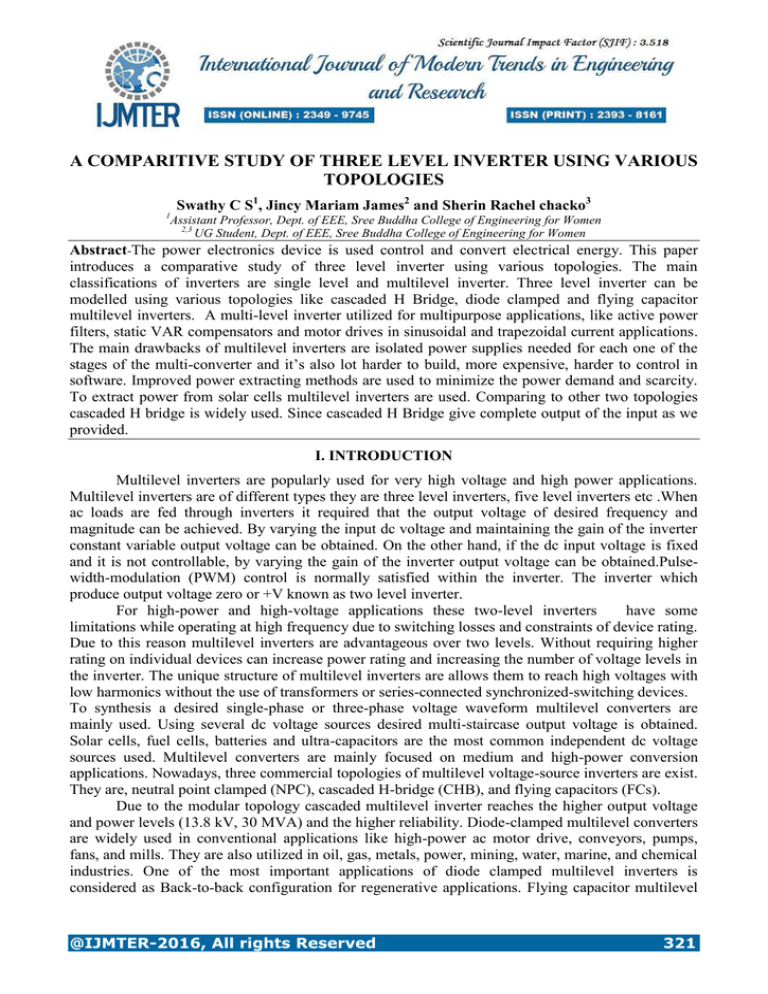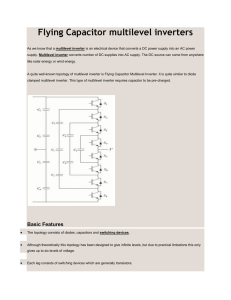
A COMPARITIVE STUDY OF THREE LEVEL INVERTER USING VARIOUS
TOPOLOGIES
Swathy C S1, Jincy Mariam James2 and Sherin Rachel chacko3
1
Assistant Professor, Dept. of EEE, Sree Buddha College of Engineering for Women
2,3
UG Student, Dept. of EEE, Sree Buddha College of Engineering for Women
Abstract-The power electronics device is used control and convert electrical energy. This paper
introduces a comparative study of three level inverter using various topologies. The main
classifications of inverters are single level and multilevel inverter. Three level inverter can be
modelled using various topologies like cascaded H Bridge, diode clamped and flying capacitor
multilevel inverters. A multi-level inverter utilized for multipurpose applications, like active power
filters, static VAR compensators and motor drives in sinusoidal and trapezoidal current applications.
The main drawbacks of multilevel inverters are isolated power supplies needed for each one of the
stages of the multi-converter and it’s also lot harder to build, more expensive, harder to control in
software. Improved power extracting methods are used to minimize the power demand and scarcity.
To extract power from solar cells multilevel inverters are used. Comparing to other two topologies
cascaded H bridge is widely used. Since cascaded H Bridge give complete output of the input as we
provided.
I. INTRODUCTION
Multilevel inverters are popularly used for very high voltage and high power applications.
Multilevel inverters are of different types they are three level inverters, five level inverters etc .When
ac loads are fed through inverters it required that the output voltage of desired frequency and
magnitude can be achieved. By varying the input dc voltage and maintaining the gain of the inverter
constant variable output voltage can be obtained. On the other hand, if the dc input voltage is fixed
and it is not controllable, by varying the gain of the inverter output voltage can be obtained.Pulsewidth-modulation (PWM) control is normally satisfied within the inverter. The inverter which
produce output voltage zero or +V known as two level inverter.
For high-power and high-voltage applications these two-level inverters
have some
limitations while operating at high frequency due to switching losses and constraints of device rating.
Due to this reason multilevel inverters are advantageous over two levels. Without requiring higher
rating on individual devices can increase power rating and increasing the number of voltage levels in
the inverter. The unique structure of multilevel inverters are allows them to reach high voltages with
low harmonics without the use of transformers or series-connected synchronized-switching devices.
To synthesis a desired single-phase or three-phase voltage waveform multilevel converters are
mainly used. Using several dc voltage sources desired multi-staircase output voltage is obtained.
Solar cells, fuel cells, batteries and ultra-capacitors are the most common independent dc voltage
sources used. Multilevel converters are mainly focused on medium and high-power conversion
applications. Nowadays, three commercial topologies of multilevel voltage-source inverters are exist.
They are, neutral point clamped (NPC), cascaded H-bridge (CHB), and flying capacitors (FCs).
Due to the modular topology cascaded multilevel inverter reaches the higher output voltage
and power levels (13.8 kV, 30 MVA) and the higher reliability. Diode-clamped multilevel converters
are widely used in conventional applications like high-power ac motor drive, conveyors, pumps,
fans, and mills. They are also utilized in oil, gas, metals, power, mining, water, marine, and chemical
industries. One of the most important applications of diode clamped multilevel inverters is
considered as Back-to-back configuration for regenerative applications. Flying capacitor multilevel
@IJMTER-2016, All rights Reserved
321
International Journal of Modern Trends in Engineering and Research (IJMTER)
Volume 03, Issue 04, [April– 2016] ISSN (Online):2349–9745; ISSN (Print):2393-8161
converters have been used in the applications required high-bandwidth and high-switching
frequency. Such as medium-voltage traction drives.
For sensitive loads and emergency communications needs high power and power quality, in
such cases Cascaded H-bridge multilevel converters have been applied. Static synchronous
compensators and reactive power compensators are the applications; photovoltaic power conversion,
uninterruptible power supplies, and magnetic resonance imaging are the several examples. Ones of
the growing applications for multilevel inverter electric motor drives and hybrid power trains. By
increasing voltage levels the number of switches also will increase in number. As a result the voltage
stresses and switching losses should increase and the circuit will become more complex.
By using the proposed topology efficiency can be improved by reducing the number of
switches. In high power applications, to avoid distortion in the grid and to reach the maximum
energy efficiency the harmonic content of the output waveforms has to be reduced as much as
possible. When compared to the higher order harmonics, lower harmonics make more effects on the
output. It is big challenge for any researcher to eliminate the third order harmonics using simple
techniques, for a motor load its effects are high. This paper implements a new method to eliminate
lower order harmonics. Selective Harmonics elimination technique is used. By using this technique
third and fifth order harmonics are eliminated. To solve transcendental non linear equations
numerical technique known as Newton Rapson method is adopted. By using this method Cascaded
H-bridge seven level inverter is modelled and harmonic analysis is carried out and finally the
hardware for the proposed topology is implemented and experimental results are presented.
II. THREE LEVEL INVERTER
Three level inverter topology, also known as Neutral Point Clamped (NPC) inverter.
Compared to two level inverters, three- level inverter offers several advantages such as smaller
output voltage steps and provides the cleaner output waveform. And having an effective switching
frequency twice that of the actual switching frequency. In two level inverter the components will be
smaller and less costly than three level inverter. Topology traditionally has been used for medium
voltage drives both in industrial and other applications. Three level inverter can use various
topologies like cascaded h bridge, diode clamped and flying capacitor.
Fig: 1 Circuit diagram of a three level invertr
III. MULTILEVEL INVERTER TOPOLOGIES
The basic three types of multilevel inverter topologies are;
1. Diode clamped multilevel inverter
2. Flying capacitor multilevel inverter
3. Cascaded multilevel inverter
IV. DIODE-CLAMPED MULTILEVEL TOPOLOGY
Due to capacitor voltage balancing issues, the diode-clamped inverter implementation has
been mostly limited to the three levels. Because of industrial developments over the past several
years, the three level inverter is now used extensively in industry applications. Although most
@IJMTER-2016, All rights Reserved
322
International Journal of Modern Trends in Engineering and Research (IJMTER)
Volume 03, Issue 04, [April– 2016] ISSN (Online):2349–9745; ISSN (Print):2393-8161
applications are medium-voltage, a three-level inverter for 480V.But the structure is more
complicated than the two-level inverter, the operations straight forward and well known. In
summary, each phase node can be connected to any node in the capacitor bank Connection of the
phase to junctions can be accomplished by switching both transistors are off and on. These states are
the same as the two-level inverter yielding a line-to-ground voltage it is mainly uses diode to provide
multiple voltages along with capacitor bank which are in series. Diode transfers a limited amount of
voltage, thereby reducing the stress on other electrical devices. Maximum output voltage is half of
the input dc voltage.f zero or the dc voltage.
Fig: 2 Diode clamped multilevel inverter
APPLICATION
Static VAR compensation
Variable speed motor drives
High voltage system interconnections
High voltage DC and AC transmission lines
V.FLYING CAPACITOR MULTILEVEL TOPOLOGY
The flying capacitor multilevel topology considered to be the most serious alternative to the
diode clamped topology. Compared to neutral point clamped converters a high number of auxiliary
capacitors are neededThe main concept of this inverter is to use capacitors. It is series connection of
capacitor clamped switching cells. Its operation is similar to diode clamped multilevel inverter
Clamping diodes are not required. . The structure of this inverter is similar to that of the diodeclamped inverter except that instead of using clamping diodes, the inverter uses capacitors in their
place. The circuit topology of the flying capacitor multilevel inverter is shown in Fig. This topology
has a ladder structure of dc side capacitors, where the voltage on each capacitor differs from that of
the next capacitor. The voltage increment between two adjacent capacitor legs gives the size of the
voltage steps in the output waveform.
Fig: 3 Flying capacitor multilevel inverter
@IJMTER-2016, All rights Reserved
323
International Journal of Modern Trends in Engineering and Research (IJMTER)
Volume 03, Issue 04, [April– 2016] ISSN (Online):2349–9745; ISSN (Print):2393-8161
VI. APPLICATIONS
Induction motor control using DTC (Direct torque control) circuit.
Static VAR generation.
Both the ac-dc and dc-ac conversion application.
Sinusoidal current rectifiers
VII.CASCADED INVERTER WITH SEPARATE DC SOURCE
This type of converter does not need any transformer clamping diodes, or flying capacitors;
each bridge converter generates three levels of voltages. For a three-phase configuration, the
cascaded converters can be connected in star or delta. This inverter is nothing but series connection
of single connection of single phase inverter with separate dc source. This inverter can be avoiding
the extra clamping diodes or voltage balancing capacitor. Each separate dc source (SDCS) is
connected to a single-phase full-bridge, or H-bridge, inverter. Each inverter level can generate three
different voltage outputs, +Vdc, 0, and –Vdc.
Fig: 4 Cascaded multilevel inverter
APPLICATIONS
Motor drives
Active filters
Electric vehicle drives
DC power source utilization
Static VAR compensator
Interfacing with renewable energy source
Table 2.1: Comparison of different multilevel inverter topology
Topologies
Power
semiconductor
switches
DIODE
2(m-1)
CLAMPED
FLYING
2(m-1)
CAPACITOR
CASCADED H 2(m-1)
BRIDGE
Clamping diode Bus capacitor
per phase
Balancing
capacitor
phase
(m-1)(m-2)
(m-1)
0
0
(m-1)
(m-1)(m-2)/2
0
(m-1)/2
0
@IJMTER-2016, All rights Reserved
per
324
International Journal of Modern Trends in Engineering and Research (IJMTER)
Volume 03, Issue 04, [April– 2016] ISSN (Online):2349–9745; ISSN (Print):2393-8161
VIII. CONCLUSION
The general concept of multilevel power conversion was introduced more than twenty years
ago. However, most of the development in this area has occurred over the past five years.
Furthermore, each year seems to bring even more publications than the previous. Besides the
mainstream power electronics conferences and journals, multilevel power conversion is also showing
up in power systems and electronics societies. Despite the rapid growth of this area in recent years
and the increasing number of innovations introduced each year, there is still much more that can be
done. The author has contributed to this field over the past ten years and encourages other
researchers to expand this work in the context of other, closely related, research areas alluded to
herein. Although numerous topologies and modulation methods were discussed, several more can be
found in the references and in the literature. An additional goal of this monograph was to introduce
concepts related to reducing the number of isolated voltage sources and sensors. This can be
important in the high power quality cascaded multilevel inverters which require several voltage
sources and knowledge of the dc voltage levels. Applications of the cascaded multilevel inverter
include naval ship propulsion which necessitates high power quality.
REFERENCES
[1] J. Rodriguez, J. S. Lai and F. Z. Peng, “Multilevel Inverters: Survey of Topologies,Controls,
[2] J. S. Lai and F. Z. Peng, “Multilevel Converters-A new Breed of Power Converters,”IEEE Trans.
[3] L. M. Tolbert, F. Z. Peng, and T. Habetler, “Multilevel Converters for Large Electric drives,” IEEE Trans.
[4] R. H. Baker and L. H. Bannister, “Electric Power Converter,” U.S. Patent 3 867 643, Feb. 1975.
[5] A. Nabae, I. Takahashi, and H. Akagi, “A New Neutral-point Clamped PWM inverter,” IEEE Trans. Ind. Applicat.,
[6] R. H. Baker, “Bridge Converter Circuit,” U.S. Patent 4 270 163, May 1981.
[7] P. W. Hammond, “Medium Voltage PWM Drive and Method,” U.S. Patent 5 625 545,Apr. 1977.
[8] F. Z. Peng and J. S. Lai, “Multilevel Cascade Voltage-source Inverter with Separate DCsource,”
[9] P. W. Hammond, “Four-quadrant AC-AC Drive and Method,” U.S. Patent 6 166 513,Dec. 2000.
@IJMTER-2016, All rights Reserved
325






